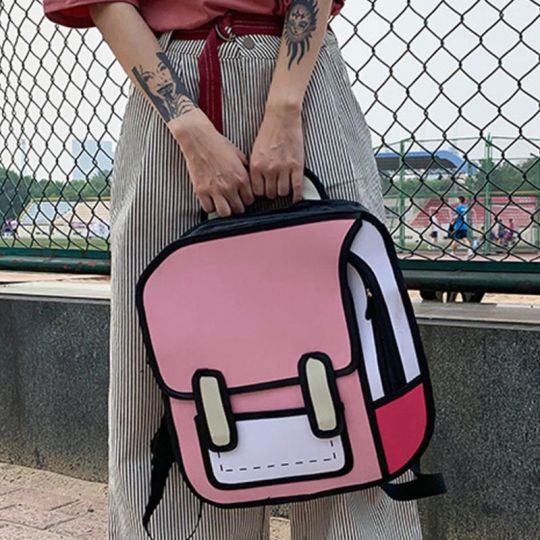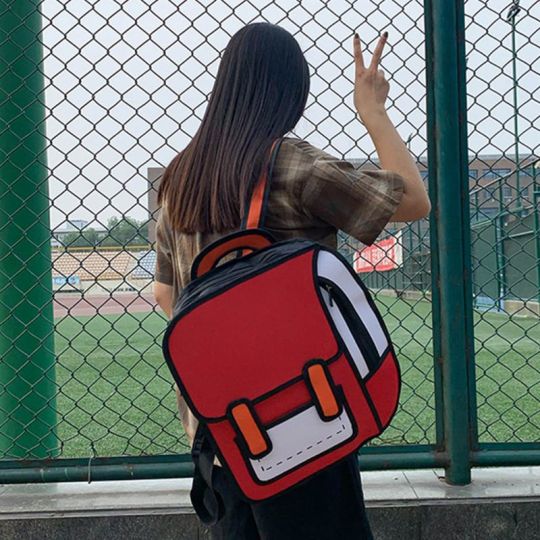Text
Kawaii 2d Cartoon Canvas Backpack





🏷️ Happy Sunday! Sale now on!! Get Kawaii 2d Cartoon Canvas Backpack for just $34.59
Now Get:https://www.kawaiifashionshop.com/product/kawaii-2d-cartoon-canvas-backpack/
With this Kawaii 2d Cartoon Canvas Backpack, you don’t need to worry about what’s inside. Just put in some books or other things, and enjoy yourself! This kind of backpack style looks very stylish, delicate, and simple but still shows its unique character.
93 notes
·
View notes
Text
What is kawaii clothing?
“Kawaii” has a specific style. It is a word used to describe clothes with layers and bright or pastel colors. It is a look that has become increasingly popular in Japan during the last decade, mostly because of the rise of fashion magazines and trendy clothing stores.
It can be confusing, however, because kawaii clothing also means “cute” clothes for boys and girls. And kawaii means fun things for girls and boys alike.
Because of this confusion, I want to define what it means for your product to be kawaii, or cute. (Of course, you don't have to put your logo on everything you sell.)
A kawaii item could be anything from a cute panda to a beautiful flower arrangement. Or it could be something totally different — maybe an outfit with layers and bright colors or a dress with ruffles that looks like a fluffy bunny coat!
For clothing items, the simplest way to do this would be by listing all the details about each item: garment length (in cm), sleeve length (in cm), neckline (in cm), color/pattern/design etc… Also consider whether you can use images in your offer or if you just need words describing the items.
If you want some inspiration for what kind of clothing items are most likely to catch attention from customers then check out The Kawaii Style Guide .
Kawaii Fashion
I’m sure you’ve heard of kawaii, but did you know that there are many different types of kawaii clothing?
There are two main types of kawaii clothing:
• Kawaii clothes for children
• Kawaii clothes for adults.
There is also a third type of kawaii clothing that I personally don’t like much:
• Kawaii clothes for women.
So, which is better? Which one is more kawaii? And why do so many people use the word “kawai” as if it means “cute” when in fact (on the internet) it only means “cute”?
I was curious to find out more about the differences between these three types of clothing and I went on a few different websites (notably sites related to Japanese culture) to see what they had to say. They all agree with me when they say that traditionally, in Japan, children often wore their clothes without any frills or embellishments. The same goes for children generally and adults who want something unique for their outfits. Neither does this apply to adults in the U.S., however; here, people tend to wear oversized t-shirts and shorts very often, which can be considered more casual. In short, what makes someone “kawai” depends on which group they belong to and how they dress (which isn’t necessarily very kawai at all). So if you think your outfit is too feminine or too masculine, you should probably consider switching it up a bit — unless you live in Japan or have a pretty close relative who lives there.
Kawaii Fashion in Japan
In Japan, we see a lot of kawaii fashion. A lot. Some of the biggest brands here in the states have a presence there (and work hard to expand into Japan), but some are just starting to make their mark on the Japanese market. We’re not going to try and actually make kawaii clothes, but rather use it as a way to talk about how Japanese people think about fashion — both by themselves and with us.
Although it is not new, Japanese fashion has always been part of our culture: from traditional costumes such as those pictured above to modern trends like the ubiquitous poncho-style rain coats which Westerners often associate with the country, or oh my goooooooodness, that crop top!
We hope this post will give you an idea of some of the things you can do to introduce yourself to people who might be interested in your brand or product without seeming like a tourist. You don't need expensive shoes or handbags (though they're good!), but you do have to have fun. And don't worry if your outfit doesn't fit perfectly: no one is going to be judging you anyway!
Kawaii Fashion around the world
If you are interested in kawaii fashion around the world, you might want to read this post, which is an overview of some of the most popular kawaii fashion trends.
The inspiration for this post came from Tania Rheingold’s recent post on Kawaii, where she wrote that even though Japan is known as the originator of kawaii, many European countries have taken up and adapted the style. And while it might seem that all of these countries have relatively similar styles, they have very different cultural contexts. For example, in China, the concept of uniformity and appearance is paramount: if a person has a particular hairstyle or color palette, he or she is expected to keep to that style. This can easily become a negative experience because it can be difficult to break out of the mold and start over when faced with new situations or new people.
The same goes for other aspects of Chinese culture: men typically wear trousers with shoes that match their dress shoes; women wear skirts that match their dresses; men use brush-cut hair; women use bobbed hair; men wear eyeglasses; women use contact lenses; men generally don’t work outside the home (or at least not on weekends for long); and so on. When different cultural contexts come together, sometimes things can take on completely different meanings.
Conclusion
If you’ve looked at the “Product Marketing” section in this article, you may have noticed that I’m not focusing on your product to the exclusion of everything else. My focus is on being an effective marketer, and I want to help you understand how to do that better.
That means we need to understand the marketing aspects of your product as well as its potential market. And if you are new to marketing, it will help here too.
The fact is that no matter what marketing plan you have, it probably won't be enough. This is because there are so many different kinds of marketing, each with its own strategies and tactics — and each trying to do something unique for its own customer group or niche. You can only try one thing at once if multiple things aren't working for your target customer (and their competitors). It's also common for your product's marketing team to be battling it out with a direct competitor who uses a different strategy or some other feature/component that your product doesn't have (or at least doesn't use as effectively).
There also certainly is a certain amount of overlap between products — but even then, some products have very different needs and goals from others. For example, Apple's iPod has very little in common with Microsoft's Zune; even though they might look the same on the surface (Zune uses iTunes), their goals are very different: Zune wants users to listen to music wherever they go while Apple wants them to use their phone as a media player (or more precisely: listen to music where they go).
When it comes down to it though, what matters most is what works best for your target customers if you continue doing what you're doing now. What makes sense for them should work best for everyone else too — so make sure that all aspects of your product are working towards that goal.
12 notes
·
View notes